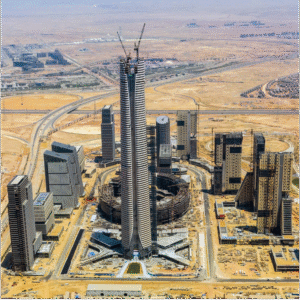16-year-old Arnav Maheshwari explores the promises and controversies of Egypt’s new capital project

The Iconic Tower in the Central Business District, part of the New Administrative Capital, Egypt.
Picture by: Imago | Alamy
Article link copied.
May 23, 2025
Egypt’s NAC: The new Dubai or a far-fetched desert dream?
In 2015, under then new president Åbdal Fattah el-Sisi, Egypt unveiled its plans for a New Administrative Capital (NAC), aiming to alleviate Cairo’s chronic congestion, which has made it one of the most overcrowded places in the world, with more than 23 million residents in the Greater Cairo area.
Located 45 kilometres east of Cairo, deep in the desert, the NAC will boast state-of-the-art infrastructure, government and business districts, and housing for more than six million residents. Officials hope the mega-project – which is expected to cost around $58bn in total – will draw multinational corporations and boost private sector confidence, instilling hope in a crippled economy.
Harbingers’ Weekly Brief
The new city is being built in phases. Buildings in phase one include a new presidential palace, the 70-storey Iconic Tower (Africa’s tallest skyscraper), two huge places of worship, the Egypt Grand Mosque and the Cathedral of the Nativity of Christ, and a massive new HQ for Egypt’s ministry of defence, dubbed the “Octagon” due to its shape.
As its temporary name suggests, the new city will become the country’s administrative capital. Government ministries are moving from historic Tahrir Square in Cairo to a much more consolidated location in the NAC. The first wave of relocations took place in early 2023: 14 ministries and public institutions have already moved to their new headquarters.
This relocation is a part of Egypt Vision 2030,the country’s ambitious national development strategy to upscale its infrastructure and boost its economy, from the historic lows in 2024 marked by 35% inflation. This decline is exacerbated by the country’s position in the crosswinds of various armed conflicts,which jeopardise tourism and trade networks – two major moneymakers for the country.
The staggering cost of the NAC is primarily financed through foreign loans, with significant backing from Gulf states such as the United Arab Emirates, as well as major Chinese investment. Chinese companies, specifically the state-owned China State Construction Engineering Corporation (CSCEC), have played a key role in developing major infrastructural projects within the NAC
Egypt’s leaders view the NAC as a new economic hub, making the country a premier destination for businesses in North Africa.
The government hopes to boost private sector confidence and attract multinational companies, demonstrating a commitment to economic reform and growth while incentivising foreign investments.
Critics claim that the NAC is not only an urban planning scheme but also a deliberate bid to centralise state power under Egypt’s authoritarian regime. They say the government is trying to minimise the chances of political uprisings near the heart of its operations by relocating key government buildings out of Cairo’s old districts, which were accessible to the general population.
The design of the NAC encompasses extensive security capabilities, with more than 6,000 surveillance cameras monitoring the city, which will enhance governmental oversight and control.
While the NAC is formulated as an economic reform accelerator at the country level, there is widespread scepticism from the general public. In answer to concerns about the high cost of the new presidential palace, President El-Sisi emphasised that all the state buildings in the new capital were financed by the Administrative Capital for Urban Development (ACUD).
For some, the NAC is the inevitable solution to Cairo’s rampant urban sprawl.
Fakhri al-Fekki, a former economic official at the International Monetary Fund (IMF), argues that the relocation of government institutions is long overdue, stating: “Transferring government buildings to a new city is now a necessity.”
The rationale behind this move is shared by many who believe Cairo’s congestion is unsustainable. The Greater Cairo Metropolitan Area has more than 19,000 people per square kilometre, making it one of the most densely populated urban centres in the world.
Ahmed Belal, a 39-year-old doctor from Cairo, acknowledges the need for development but worries about the broader consequences of Egypt’s urban expansion bid, such as the loss of green areas.
He moved after the trees near his apartment were cut down due to road expansion. “I sold my apartment… to have a little bit of peace of mind and some green areas that I hope they won’t go after,” he explained.
Critics argue that the NAC is less about necessity and more about excessive ambition. Egyptian billionaire and industrialist Naguid Sawiris warned that these mega-projects could further strain national finances rather than stimulate long-term growth: “We have an overambitious president who is doing mega projects that are requiring a lot of foreign currency and we should have a second look at these projects.”
Also, many Egyptians question whether the NAC serves the general public or the elite. With a GDP per capita of just $3,513 in 2023 and the top 10% holding 73.3% of the nation’s wealth, economic equality remains stark. Critics argue that while billions are pumped into a futuristic capital, millions still face inflation, unemployment and deteriorating public services.
Will this grand project drive economic revival for tens of millions of Egyptians, ease Cairo’s urban chaos and position Egypt as a regional powerhouse? Does the NAC have the potential to transform into a modern-day Agrabah, a kingdom gleaming with opportunity and prosperity? Or is it a debt-fuelled mirage?
Written by:

Economics Section Editor 2025
Georgia, United States
Born in 2009, Arnav studies in Metro Atlanta in the United States. He is passionate about economics, investing, and finance, with plans to study economics at university.
Arnav joined Harbingers’ Magazine in October 2024 as a winner of The Harbinger Prize 2024 in the Economics category, earning a place in the Essential Journalism Course. During this time, while writing about the global economy, entrepreneurship, and macroeconomics, he demonstrated outstanding writing skills and dedication to the programme. His commitment earned him the position of Economics Section Editor in March 2025.
In his free time, Arnav holds leadership roles in finance-focused organisations at state and national levels and is the founder of a SaaS startup. He hopes to use his writing and leadership skills to contribute to social entrepreneurial efforts.
Arnav speaks English and Hindi fluently, with working proficiency in Spanish.
Edited by:

🌍 Join the World's Youngest Newsroom—Create a Free Account
Sign up to save your favourite articles, get personalised recommendations, and stay informed about stories that Gen Z worldwide actually care about. Plus, subscribe to our newsletter for the latest stories delivered straight to your inbox. 📲
© 2025 The Oxford School for the Future of Journalism


